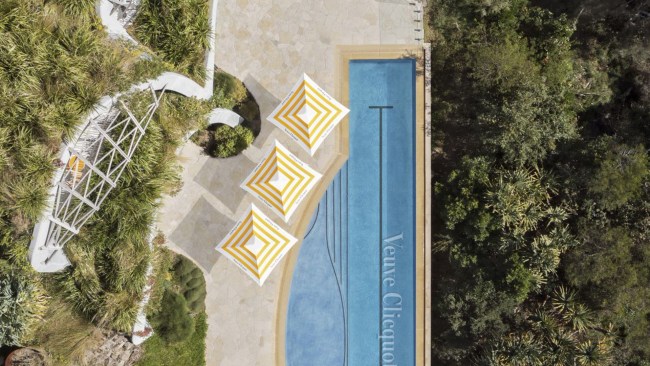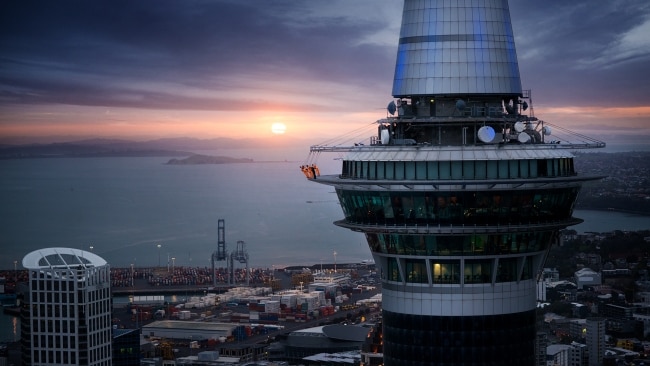Excess all areas on the Orient-Express
THE fabled Venice Simplon-Orient-Express sweeps passengers into the pages of an Agatha Christie mystery.

NOTHING captivates travellers more than the utterly unlikely. And that is how it feels aboard the Venice Simplon-Orient-Express.
It is like entering a fable, a myth made excessively real, a thing if not of flesh and blood then of steel and silver, tasselled lamps, mahogany inlays and etched glass. I couldn't feel more aspic-set in an Agatha Christie novel than if Hercule Poirot were to pop into my compartment to share a tisane.
It is not a little Belgian detective with finely attuned "little grey cells" who joins me but the blue-uniformed steward for carriage C, Rupert from Jamaica. Handsome and funny, he has a sunshine smile that could light the whole train.
We are setting off from Venice bound for Budapest, a journey of one night; there are no bathrooms on board the vintage train, so passengers must make do for overnights with a discreet wash at a basin concealed in each compartment and a lavatory down the corridor of each carriage. This is an important point as it determines the train's stop-start itineraries; after two nights in Budapest (the crew also sleep "on shore", says Rupert), we will travel to Calais via Paris and connect to coaches through the Channel tunnel to Folkestone, where we'll board the 1920s carriages of its sister train, the British Pullman, bound for London's Victoria Station.
There is the same excitement in the air as when sailing on a grand ocean liner; boarding a plane just can't compare. The experience is all about the journey, the destinations mere punctuation points in an exotic narrative. Like those serial cruisers who never go ashore at ports of call, I imagine there are train buffs who would rather nest on board than explore the great capitals of Europe.
It is the wrong time of year for blizzards, but I can't help wishing for a snowstorm to stop us in our tracks, in the style of Christie's Murder on the Orient Express, although perhaps we could do without the jewelled Russian princesses, blustering English colonels, Americans dressed as Tyrolean goatherds and suchlike suspects.
As we leave St Lucia station, the watery world of Venice slips away in the fading light of late afternoon; we cross the Ponte della Liberta causeway bridge and leave behind freeways, car parks and a cruise ship terminal, all appearing so earthly and tethered as the 17-carriage train rushes into the still-bright summer evening.
There are 180 passengers aboard for this entire journey (about half on this first leg); the maximum is 265. It's hard to work out the exact mix of nationalities but there are Brits aplenty, a few Australians and Americans, many French couples, and effortlessly elegant Italians drinking Camparis before noon.
It's not quite a cast of crime-novel characters, although whenever one is thrust together with strangers, murderous fancies can occur and potential corpses unknowingly identify themselves within moments. I am reading a 1920s mystery novel and here on this country house on rails I rather want a chap with a name like Fotheringay to collapse at breakfast into a dish of devilled kidneys, a silver letter-opener in his back.
Instead of which Rupert appears, beaming like summer and smelling of coal, with afternoon tea. Rupert is a boilermaster as well as white-gloved steward and origami master of bedmaking. At the end of each compartment is a coal-fed boiler that he must replenish and stoke at regular intervals to keep us warm and the water supply hot.
The Orient-Express has its own ecosystem, code of conduct and precise timetable. Pastry chefs are up by 5am baking pastries, croissants and apple tartlets; the kitchen brigade is readying brunch items such as broiled lobster with fresh cress butter.
Someone is in charge of dainty desserts such as thin layers of biscuit with pistachios and honey-glazed roast fig.
Continental breakfast (juice, pastries, creamy French butter and little pots of jam in dense flavours such as fig and blueberry) and morning and afternoon teas are served in passenger compartments; the accommodations are small but ingeniously organised in terms of storage. I am travelling in a group and we each have a compartment so only the bottom bunks are in service; Rupert performs gymnastic feats each evening to convert the daytime couches to beds, with monogrammed linen and pillow-fairy gifts.
I wouldn't like to be sharing a compartment; there would be fights over who would have to climb up to the precarious top bunk and barely space to swing a cake. But it would be fun, too, a bit like a first-class dormitory, with no prospect of bossy matron and boiled cabbage.
We cross the Italy-Austria border bound for Vienna's Westbahnhof station, where we stretch our legs and look admiringly at an arcade of shops with windows full of bread and flowers. Back on board and we pass banks of red-berried bushes, fields turned in orderly furrows, clusters of farmhouses with deep eaves, wind farms with tall white towers whirring like swarms of sci-fi insects.
In the three dining cars - Lalique (with its beautiful frosted glass panels), Etoile du Nord and Chinois - the silver-service waiters have the shunt and sway of the train worked out perfectly, like showmen jugglers. They lean at a practised angle, trays just so, as if the glasses are glued on.
Dinner is a fine and hearty table d'hote repast and if you want to go madly off the rails with alternatives of, say, Scottish smoked salmon, Beluga caviar or foie gras, you'll pay extra. But the standard menu is a delight, with such details as fine Colombian coffee and plates of sweet and lovely mignardises at the close of dinner. The cheapest bottle of wine available on board is €31 ($46) for a soave classico.
There's an old saying that goes, "You can't overdress on the Orient Express." Sadly on this trip there are few furs with startled fox heads, cloche caps or slinky gowns. But most passengers do dress up a tad, and dark suits and black cocktail frocks are the order of the evening.
The bar car, with its weaving waiters and baby grand piano, stays open until the last passenger leaves. The record, says Rupert, is rumoured to be 7am.
"An Australian, a Greek and an Irishman," he hoots.
Next day, at the pip of 2.41pm, and after a thorough lunch, we make our grand arrival at Budapest's Nyugati Palyaudvar Station. In the Hungarian capital we stay at the splendid art deco Four Seasons Budapest, as friendly and cosy as it is palatial, and eat cream cakes and schnitzels the size of hot-water bottles; it's a beautiful city of majestic bathhouses, and 10 arched bridges that sweep over the Danube, joining Buda and Pest, providing symmetry and elegance as well as unity.
But we are anxious to reclaim our compartments on the Orient-Express and at 9.12am we are back on board, Rupert greeting us with promises of elevenses of creamy delicacies from Budapest's Cafe Gerbeaud and a flute of Orient-Express champagne.
I imagine I am gaining a kilo a day; there's little kilojoule-burning to be had in games of cards and Travel Scrabble and sunny naps on my compartment's couch.
Back into Austria we race and it's all gabled houses and geranium-filled window boxes, hikers with stout walking sticks standing on tidy platforms with names such as Purkersdorf.
We speed past well-swept suburbs, embankments thick with fir trees and rows of poplars turning to autumn colours.
These are contented landscapes of fat brown and white cows and villages with gilded church clock towers that shine in the light of late afternoon.
There is a percussion to the train, a gentle rocking that allows me to sleep bug-snug in my single bed in the fashion of my childhood. The pink-shaded lamp shines on the polished art deco marquetry; Rupert has tucked my bags, books and travel items in nooks around the compartment so there are no bangs and bumps in the night.
Munich, Stuttgart and an unspooling reel of towns and villages dissolve into darkness and I wake to see that signs have turned from German to French; we are in Champagne and now there are chateaus, chaps in berets shooting at rabbits and ground birds, canals and willows, gliding white swans and old Peugeots.
Village high streets boast patisserie, boulangerie and bijouterie, "Giles le peinteur" is wiping his billboard, high-speed trains are parked at shunting sheds on the outskirts of Paris like so many long pencil-cases.
Chef de cuisine Christian Bodiguel has been aboard for 25 years and for our quick halt at Paris's Gare de l'Est he emerges from his tiny galley kitchen to oversee the loading of provisions. He hails from Brittany and his passion is cold-water seafood; we watch lobsters being inspected, tomatoes from the sunny climes of Provence, red-and-white cartons of fruit from les jardins des tropiques, trays of plump asparagus and earthy potatoes.
Bodiguel breaks into a special smile at the prospect of premium saltmarsh lamb from the bay of Mont St Michel.
It was from this station (then the Gare de Strasbourg) that the first Orient-Express service steamed off in 1833, headed for what was then Constantinople, with much fanfare and a swell of pressmen on board, including the grandly named Henri Opper de Blowitz of The Times, who regaled his readers with news of such astonishments as cakes of soap on the washbasins.
The journey included stops in Budapest and Bucharest and involved a ferry crossing; the Orient-Express used different rolling stock on its services and was never just one train. By the mid-20th century, luxury rail travel in Europe was in decline; enter Orient-Express Hotels chairman James B. Sherwood, who purchased two old Pullman cars at an auction in 1977. The restoration of these, and a string of other historic carriages, heralded the revival of the Venice Simplon-Orient-Express in 1982.
There are few travel experiences in our helter-skelter world that deliver such a romantic sense of history.
Some travellers may complain of the lack of showers and airconditioning, the smallness of the compartments, the absence of power points for hair dryers and mobile phone rechargers, and the meal seating times (6.30pm may seem too early for dinner; 9pm is late for many travellers, except the Spanish with their special powers of nocturnal digestion).
But these detractors are missing the point. This anachronistic train really has no right of survival but, despite the odds, it trundles on, delivering a sense of continuum, of creaky charm, of the age-old possibilities of mystery and improbable liaisons and adventure. Do put it on your list.
Susan Kurosawa was a guest of Singapore Airlines and Orient-Express.
Checklist
If you're quick, you can book a Venetian Indulgence special that covers one night at Hotel Cipriani in Venice and a trip aboard the Venice Simplon-Orient-Express from Venice to London or Paris.
Cost is $3700 a person twin-share if booked by March 24 for selected departure dates throughout 2010. Transfers and meals on board are included.
The Venice-Budapest-London journey described in this feature is $4520 a person twin-share; check website for seasonal specials. More: 1800 000 395; www.orient-express.com.
Singapore Airlines offers Airbus A380 services to London from Melbourne and Sydney via Singapore. It also flies A380s to Tokyo, Paris and Hong Kong. For best deals and seasonal fares from Australian ports: www.singaporeair.com.au.



